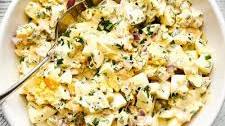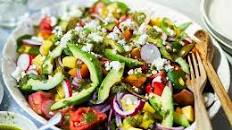Delicious Egg Salad Recipe: A Simple and Satisfying Dish

The Perfect Egg Salad Recipe
Looking for a simple yet delicious dish to enjoy for lunch or as a side? Try this classic egg salad recipe that never fails to satisfy. With its creamy texture and rich flavour, it’s sure to become a favourite in your recipe collection.
Ingredients:
- 6 hard-boiled eggs
- 1/4 cup mayonnaise
- 1 tablespoon Dijon mustard
- 1/4 cup finely chopped celery
- 2 tablespoons finely chopped red onion
- Salt and pepper to taste
- Fresh chives for garnish (optional)
Instructions:
- Peel the hard-boiled eggs and chop them into small pieces.
- In a mixing bowl, combine the chopped eggs, mayonnaise, Dijon mustard, celery, and red onion. Mix gently until well combined.
- Season with salt and pepper according to your taste preferences. Stir again to ensure the seasoning is evenly distributed.
- Cover the bowl with cling film and refrigerate for at least 30 minutes to allow the flavours to meld together.
- Serve the egg salad on its own, as a sandwich filling, or as a topping for crackers or toast. Garnish with fresh chives if desired.
This egg salad recipe is versatile and can be easily customised to suit your preferences. Feel free to add ingredients like diced pickles, fresh herbs, or a splash of lemon juice for an extra burst of flavour. Enjoy this simple yet satisfying dish any time of the day!
Bon appétit!
Eight Benefits of Egg Salad: A Versatile and Nutritious Delight
- Quick and easy to prepare
- Requires simple and readily available ingredients
- Versatile dish that can be enjoyed on its own or as a filling
- Creamy texture with a rich flavour
- Perfect for a light lunch or as a side dish
- Can be customised with additional ingredients to suit personal taste
- Provides a good source of protein from the eggs
- Refreshing and satisfying option for warm weather meals
Considerations Before Making Egg Salad: Six Potential Drawbacks to Keep in Mind
- Mayonnaise-based, which may not be suitable for those watching their calorie intake
- Contains eggs, making it unsuitable for individuals with egg allergies
- Requires hard-boiled eggs, which can be time-consuming to prepare
- The texture may not appeal to those who dislike creamy or mushy foods
- Leftover egg salad can become watery when stored in the fridge for extended periods
- The strong flavour of red onion may overpower other ingredients for some palates
Quick and easy to prepare
When it comes to the egg salad recipe, one of its standout advantages is its quick and easy preparation. With just a handful of ingredients and simple steps, you can have a delicious dish ready in no time. Whether you need a speedy lunch option or a hassle-free side dish for gatherings, this recipe’s convenience makes it a go-to choice for busy days or last-minute meal plans. The minimal effort required to create a tasty egg salad ensures that you can enjoy a satisfying meal without sacrificing flavour or quality.
Requires simple and readily available ingredients
When it comes to the egg salad recipe, one of its standout advantages is the fact that it requires simple and readily available ingredients. With just hard-boiled eggs, mayonnaise, mustard, celery, red onion, salt, and pepper, you can easily whip up a delicious egg salad in no time. This accessibility to basic ingredients makes it a convenient choice for a quick and satisfying meal or snack. Whether you’re craving a simple lunch or need a side dish for a gathering, the simplicity of this recipe ensures that you can enjoy a tasty egg salad without any fuss.
Versatile dish that can be enjoyed on its own or as a filling
The egg salad recipe offers a versatile dining experience, serving as a delightful dish that can be relished on its own or used as a delectable filling. Whether savoured as a standalone salad or sandwiched between slices of bread, this recipe’s adaptability allows for a range of dining options to suit various preferences and occasions. Its ability to seamlessly transition from a light meal to a hearty sandwich filling makes it a convenient and satisfying choice for any mealtime.
Creamy texture with a rich flavour
The egg salad recipe boasts a delightful pro with its creamy texture and rich flavour. The combination of perfectly boiled eggs, mayonnaise, and seasonings creates a harmonious blend that is both indulgent and satisfying. Each bite offers a velvety smoothness that melts in the mouth, accompanied by a depth of taste that tantalises the palate. This winning feature makes the egg salad a versatile and delectable dish suitable for any occasion.
Perfect for a light lunch or as a side dish
Indulge in the delightful simplicity of this egg salad recipe, perfect for a light lunch or as a versatile side dish. Whether enjoyed on its own or paired with your favourite main course, the creamy texture and rich flavours of the egg salad make it a refreshing and satisfying choice. Its easy preparation and ability to complement a variety of dishes make it an ideal option for those seeking a quick and delicious meal or a tasty accompaniment to any dining experience.
Can be customised with additional ingredients to suit personal taste
One of the key advantages of the egg salad recipe is its versatility in accommodating personal preferences. By allowing for the addition of extra ingredients, such as diced pickles, fresh herbs, or a touch of lemon juice, individuals can tailor the dish to suit their unique tastes and flavour preferences. This customisation aspect not only enhances the overall dining experience but also encourages creativity in the kitchen, making each batch of egg salad a personalised culinary creation.
Provides a good source of protein from the eggs
Egg salad is not only a delicious dish but also a great source of protein, thanks to the eggs it contains. Protein is essential for building and repairing tissues in the body, making it an important nutrient for overall health and well-being. By incorporating egg salad into your diet, you can easily boost your protein intake, helping you feel full and satisfied while supporting your body’s vital functions. Whether enjoyed as a standalone meal or as a tasty sandwich filling, this recipe offers a convenient and nutritious way to incorporate quality protein into your daily meals.
Refreshing and satisfying option for warm weather meals
When the temperature rises and you’re craving a light and satisfying meal, the egg salad recipe shines as a refreshing choice. With its creamy texture and rich flavour, this dish offers a delightful contrast to the heat of warm weather. Whether enjoyed on its own or as a sandwich filling, the egg salad provides a cooling sensation that is perfect for al fresco dining or picnics in the sun. Its simplicity and versatility make it an ideal option for those seeking a quick and delicious meal during the summer months.
Mayonnaise-based, which may not be suitable for those watching their calorie intake
While egg salad is a beloved dish for many, one potential drawback is its mayonnaise-based dressing. Mayonnaise is high in calories and fat, making it less suitable for individuals who are mindful of their calorie intake or following a low-fat diet. For those looking to enjoy a lighter version of egg salad, alternatives such as using Greek yogurt or avocado as a base can be considered to reduce the calorie content while still maintaining a creamy texture and delicious flavour. Making small adjustments to traditional recipes like egg salad can help cater to a wider range of dietary preferences and restrictions.
Contains eggs, making it unsuitable for individuals with egg allergies
It’s important to note that one of the drawbacks of this egg salad recipe is its primary ingredient: eggs. This makes the dish unsuitable for individuals with egg allergies or sensitivities. For those who cannot consume eggs due to allergies, it is advisable to explore alternative recipes that cater to their dietary restrictions while still providing a similar taste and texture experience.
Requires hard-boiled eggs, which can be time-consuming to prepare
While the egg salad recipe offers a delightful and creamy dish, one drawback is the necessity of using hard-boiled eggs, which can be quite time-consuming to prepare. Boiling and cooling the eggs before incorporating them into the salad adds an extra step to the cooking process, potentially making this recipe less convenient for those seeking a quick meal or snack. However, with a bit of planning and preparation, the rich and satisfying flavours of the egg salad are well worth the effort.
The texture may not appeal to those who dislike creamy or mushy foods
While the egg salad recipe offers a creamy and rich flavour profile, it may not be suitable for individuals who prefer textures that are not creamy or mushy. The soft consistency of the egg salad could potentially deter those who seek more texture variation in their meals. For individuals with a preference for crunchier or firmer dishes, this particular recipe may not align with their taste preferences.
Leftover egg salad can become watery when stored in the fridge for extended periods
One downside of the egg salad recipe is that leftover portions stored in the fridge for extended periods can sometimes become watery. The moisture from the salad ingredients, particularly the eggs and mayonnaise, can separate over time, resulting in a less appealing texture. To mitigate this issue, it is recommended to consume the egg salad within a few days of preparation or to drain any excess liquid before serving. Properly sealing the container and storing it in the coldest part of the fridge can also help maintain the salad’s consistency for longer.
The strong flavour of red onion may overpower other ingredients for some palates
Some individuals may find that the robust taste of red onion in this egg salad recipe could potentially overshadow the flavours of the other ingredients, leading to a less balanced or harmonious overall taste experience. It is important to consider personal preferences and adjust the amount of red onion used accordingly to ensure that the dish remains enjoyable for all palates.



